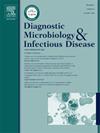Anterior nasal swabs compared to nasopharyngeal swabs for detection of respiratory viruses in children
IF 2.1
4区 医学
Q3 INFECTIOUS DISEASES
Diagnostic microbiology and infectious disease
Pub Date : 2025-03-20
DOI:10.1016/j.diagmicrobio.2025.116821
引用次数: 0
Abstract
Respiratory viral testing often uses invasive nasopharyngeal (NP) swabs, which can be painful and require trained personnel. Anterior nasal swabs (NS) are less invasive and can be self-collected. The sensitivity of NS compared to NP specimens for detecting multiple respiratory viruses in children are not well described. Hospitalized children in Kansas City, MO, from January 2023 to February 2024, who had NP specimens obtained for standard of care multiplex respiratory viral testing in the previous 72 h, were enrolled. NS specimens were collected and tested alongside salvaged NP specimens for adenovirus, seasonal coronaviruses, human metapneumovirus, respiratory syncytial virus, influenza, rhinovirus/enterovirus, SARS-CoV-2, and parainfluenza viruses using multiplex molecular testing. Concordance, sensitivity, and specificity of NS compared to NP specimens were assessed. A total of 147 paired NP/NS specimens were analyzed. Overall, 114 (77.6 %) NP/NS pairs were concordant, including 86 (58.5 %) virus-positive and 28 (19.1 %) virus-negative pairs. NS sensitivity was 84.3 % compared to NP, increasing to 95.7 % when collected within 24 h of NP specimens. Sensitivity for seasonal coronavirus was poor (36.4 %), but was over 75 % for other viruses, and 100 % for adenovirus, influenza, parainfluenza, RSV, and SARS-CoV-2 within 24 h of NP specimens. Virus cycle threshold counts were similar among paired specimens. NS specimens showed good concordance with NP specimens and high sensitivity for most viruses, except seasonal coronavirus. NS testing may enable respiratory virus monitoring outside medical settings.
求助全文
约1分钟内获得全文
求助全文
来源期刊
CiteScore
5.30
自引率
3.40%
发文量
149
审稿时长
56 days
期刊介绍:
Diagnostic Microbiology and Infectious Disease keeps you informed of the latest developments in clinical microbiology and the diagnosis and treatment of infectious diseases. Packed with rigorously peer-reviewed articles and studies in bacteriology, immunology, immunoserology, infectious diseases, mycology, parasitology, and virology, the journal examines new procedures, unusual cases, controversial issues, and important new literature. Diagnostic Microbiology and Infectious Disease distinguished independent editorial board, consisting of experts from many medical specialties, ensures you extensive and authoritative coverage.

 求助内容:
求助内容: 应助结果提醒方式:
应助结果提醒方式:


